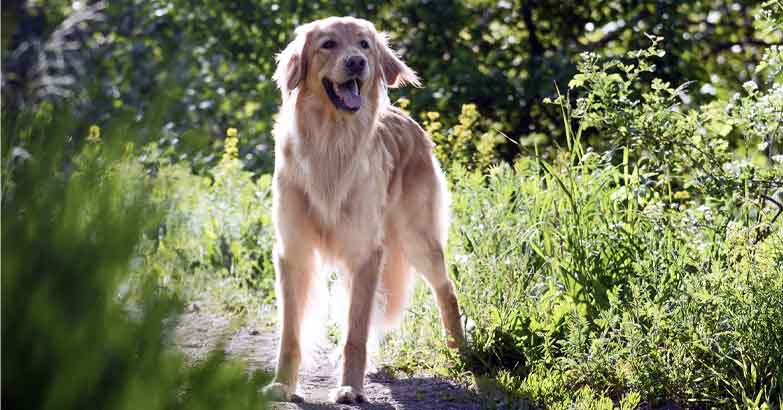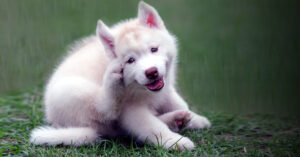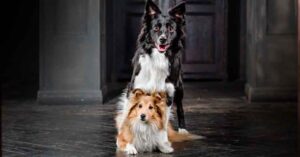Understanding your dog body language is essential for building a strong and trustworthy relationship with your furry friend. The great thing about dogs is that they won’t fake their emotions and will try to tell you how they’re feeling. It’s important to learn your dog’s communication clues and watch out for any signals that show your dog’s emotional state and overall comfort.
Here are some ways to interpret dog body language to help you understand your dog better.
#1 Tail Movement
Tail Wagging
A dog’s tail probably confuses us humans the most as we usually believe a dog with a wagging tail is a happy dog. However, this isn’t always the case. All a wagging tail means is that your dog is emotionally aroused; it could be excitement or pleasure, but it could also mean negative feelings like frustration.
So you need to look at the speed and the position of your dog’s tail.
Excited dogs hold their tails higher than a neutral position and wag them quickly from side to side. They often wiggle their hips at the same time.
An uncertain or nervous dog would also wag his tail, but would hold it slightly lower than a neutral position, wagging more slowly and steadily.
Always look at the looseness or tightness of your dog’s whole body to determine if your dog’s tail wagging is out of happiness or nervousness.
Tucked Tail
A tail tucked between the legs is an unmistakable sign that your dog is scared, in pain or feels uncomfortable. Dogs often tuck their tails between their legs when they are afraid of something or someone. On the other hand, if your pet tucks his tail often and there is no obvious reason for it, concern, it’s a good idea to ask a vet to check for medical causes.
#2 Eye Movement
Avoiding Eye Contact
Dogs who are fearful or afraid will often look away as though they are avoiding something. You often see this when you scold your dog or when your dog meets an intimidating or aggressive dog. Looking away is a calming signal to you or another dog.
Squinting
Dogs squint their eyes to indicate peaceful intention. If your dog squints his eyes when he looks at you, he’s expressing love and desire for your attention. Dogs also squint their eyes to indicate that they’re not interested in rough play. On the other hand, if your dog squints a lot, his eyes might be painful, and in this case, it’s best to take him to your vet.
Whale Eye
When a dog shows the whites of his eyes, it‘s known as whale eye. It’s a sign of stress or anxiety. You might see this when your dog is afraid someone might steal his bone or toy. When a dog is feeling tense or stressed his eyes may also appear rounder than normal.
Hard Eyes
A hard stare where your dog looks intently at something without blinking, especially for a long time, is usually a threatening signal. You will know it when you see it. His body will be stiff and his mouth tight. Your dog might be guarding a bone or feeling aggressive, or even mustering his focus for an aggressive move.
RELATED: PTSD in dogs …
#3 Ear Movement
Ears Forward
If your dog’s ears are standing straight up or, for a dog with floppy ears, inclined forward, your dog is paying close attention to something or someone. Your dog is curious and alert, possibly reacting to something new in his environment.
Ears Flattened Back
This depends on how far back your dog’s ears are. Ears that are slightly pulled back signal that your dog is feeling friendly. You often see this when you are petting your dog. But ears laid tightly back against the head usually indicates fearfulness. This is often how a dog reacts to unfamiliar situations or people or animals he’s afraid of. There are theories that this posture protects their ears from injury, by helping keep their ears out of the way of another dog’s teeth. If your dog has long, floppy ears, look at the base of the ear to really understand what your dog is trying to communicate.
Relaxed Ears
When your dog is relaxed, his ears sit in a relaxed, neutral position. His ears are not pricked forward, drooping down or flattened to the head. Whatever your dog’s breed, he’s just at ease.
RELATED: Why dog ear cropping interferes with communication …
#4 Body Signals And Posture
Exposing Belly
More often than not, exposing the belly shows trust and acceptance. When your dog shows you his belly, it’s a sign that he feels safe around you and he’s not worried that you’ll sink your jaws into his stomach. But sometimes belly exposing behavior can be a submissive display to avoid confrontation. You often see this appeasing behavior in puppies. At times, dogs may even dribble or squirt small amounts of urine to communicate a submissive status to a person or animal.
Hunching
A hunched over posture indicates your dog is fearful and feeling vulnerable. By hunching over, dogs try to make themselves smaller, almost wishing to become invisible. Dogs also hunch over when they are abused, attacked or scolded.
Turning His Back
When your canine turns his back on you, he’s showing that he’s friendly and trusts you. In the animal world, this posture puts the animal in a vulnerable state. Your dog is trusting that you won’t attack him from behind. When your dog’s back is towards you, his teeth are farthest from you, making it hard to protect himself.
Raised Hackles
A dog’s hackles are the hairs along the backbone. When your dog’s hackles are raised, it’s a clear sign he’s aroused. It can indicate fear or aggression but it’s not always negative. Your dog may also be excited or intensely interested in something. This behavior is a bit like goosebumps in humans.
Tilting The Head
For many dogs, tilting helps them hear better. Turning their ears or their entire heads can help triangulate the location of the sound, so they can hear it more clearly. Sometimes, dogs turn their heads to tilt their ears in the direction of your voice, which allows them focus more clearly on what you said.
Raised Paw
Sometimes a dog lifts one paw slightly off the ground, called pointing. It’s a common behavior in hunting breeds, to show they’ve scented or spotted prey. Or sometimes it might just mean your dog’s seen or smelled something he’s unsure of.
Play Bow
An easy-to-read part of a dog’s body language is the play bow. This is when a dog lowers his chin and elbows to the ground with his butt in the air. It’s a playful gesture and a clear sign that your dog is happy and is trying to initiate play with you or another animal.
Trembling
Trembling or shivering in response to another person or dog means your dog is scared … or it might just mean he’s cold and needs to come indoors to get warm. Smaller dogs such as Chihuahuas are more prone to shivering than larger breeds due to their lack of body fat and thinner fur. Constant shivering, on the other hand, could indicate low blood sugar (hypoglycemia) or be a sign that your dog is otherwise in pain or ill.
RELATED: Natural pain remedies for dogs …
Easing Tension
A dog who is in a challenging or unfamiliar situation may turn away and start sniffing the ground to politely avoid interaction and calm himself. This is a dog’s way of easing tension. Dogs who are feeling uncertain or anxious about a situation may also randomly begin scratching or licking themselves.
Shaking Off
When dogs shake off after a bath, the reason is clear … it’s your dog’s personal spin-drying system. Another reason is to relieve tension after an encounter that made him uncomfortable. You often see this type of shaking when your pup hops off the vet’s exam table.
Zoomies
Some dogs get very hyperactive when they’ve been in stressful situations. They might start running erratically, also known as “getting the zoomies,” as a way of blowing off that stored up tension. Dogs with the zoomies may look like they’re having a great time, but sometimes it’s just a way of releasing tension. You might see your dog getting the zoomies when he’s been confined in a crate for some time or after a bath.
Pawing You
This is usually your dog’s way of showing affection or seeking petting. We pet our pups to show our love and affection, and by putting a paw on you while you are stroking, your dog is extending contact and reciprocating affection … or asking you to keep on petting!
#5 Facial Signals
Licking You
Dogs lick you for lots of reasons. Your dog may want to show you affection and love, or even want to groom you to show concern about your wellbeing. Your dog may simply like the taste of your skin, especially if it has the residue of some yummy food!
Smiling
A dog’s mouth mimics the emotion human mouths show. A happy dog will have a soft relaxed mouth, which may look like a grin. If a dog has tensed up lips or a tight mouth, that shows tension and is not the same as a happy smile.
Baring Teeth
If a dog shows his teeth (often without growling) it’s a sign of territory protection. You’ll often see this if you try to take food away from a dog who is eating. Let your dog eat in peace, and don’t approach an unfamiliar dog or any animal who might think you’re going to steal his food. You may also see your dog bare his teeth to warn another dog to back off.
Yawning
Yawning doesn’t usually mean your dog is tired or sleepy. In dogs, yawning is often a sign of stress and indicates that your dog is feeling nervous. It’s also a calming signal, so you may see it if you scold your dog or he meets another dog who’s tense. Puppies do this often when they are in a new environment or are surrounded by larger dogs.
If your dog yawns after you do, it likely means he’s very attached to you. Recent studies have shown that dogs yawn contagiously and dogs that are bonded with their owners are more likely to yawn when their humans do.
Nose And Lip Licking
People tend to think that dogs lick their faces to mop up food leftovers, but that’s not always the case. Licking the lips or nose is also a sign of stress in dogs. Your dog is showing you a calming signal to let you know he’s stressed or feeling nervous.
RELATED: Why do dogs have whiskers?
Watch out for the above clues to help you understand and communicate with your dog better. Dogs show a large range of emotions and will communicate with you via body language.











